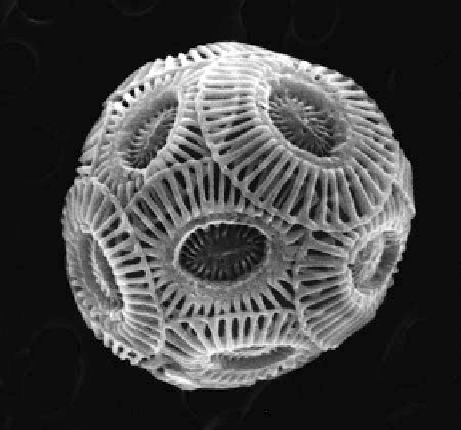Environmental Engineering Reference
In-Depth Information
Fig. 18.1
Scanning electron
photomicrograph of the
coccolithophorid
Emiliania
huxleyi
. The diameter of the
cell is approximately 12
μ
m
In the subarctic North Atlantic, Raitsos et al. (
2006
) noted that coccolithophore
abundance could be explained by increased stratification. There are predictions for
warming and large-scale freshening by increased precipitation and river outflow in
the subpolar seas (Delworth and Dixon
2000
). Understanding whether and how
E
.
huxleyi
blooms respond to changes in these and other environmental conditions
is critical to our understanding of their ecology and effect on the subpolar ecosystem.
Furthermore, although the response by
E
.
huxleyi
to ocean acidification is not yet
clear (Riebesell et al.
2008
; Iglesias-Rodriguez et al.
2008
), the uptake of atmospheric
CO
2
by the upper ocean is generally expected to adversely impact calcifying taxa,
such as
E
.
huxleyi
(Doney et al.
2009
).
Blooms of
E
.
huxleyi
occupying the surface layer are identifiable in visible
satellite observations due to their high ocean volume reflectance caused principally
by the presence of detached coccoliths (Holligan et al.
1983
). The blooms and their
associated high concentrations of calcite have been identified in ocean color
imagery from the Coastal Zone Color Scanner (CZCS) (Brown and Yoder
1994
),
Sea-viewing Wide Field-of-view Sensor (SeaWiFS) (Iglesias-Rodriguez et al.
2002
), and Moderate Resolution Imaging Spectroradiometer (MODIS) (Balch
et al.
2005
). Though a general description of the distribution of
E
.
huxleyi
blooms
was gleaned from the proof-of-concept CZCS mission that extended from 1978 to
1986, a more complete understanding of their spatial and temporal variability
awaited the launch of the dedicated SeaWiFS in 1997. Satellite ocean color data,
however, provide a limited time series to document
E
.
huxleyi
blooms. Although
not as sensitive as these ocean color sensors, Advanced Very High Resolution
Radiometer (AVHRR) imagery can also be used to detect
E
.
huxleyi
blooms and
extend the time series of their distribution back to the early 1980s.
The areal extent of
E
.
huxleyi
blooms is documented in a 25-year time series
from AVHRR in four regions around the world where
E
.
huxleyi
are prevalent and

Search WWH ::

Custom Search